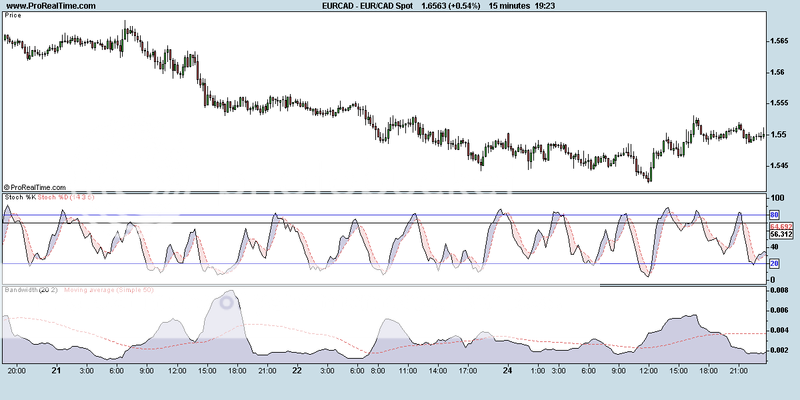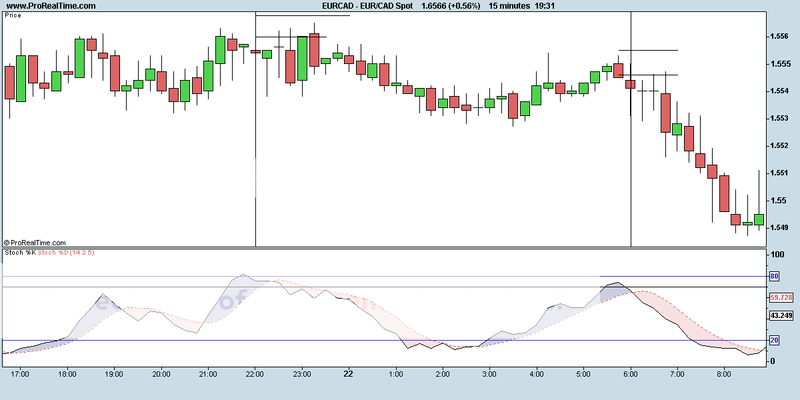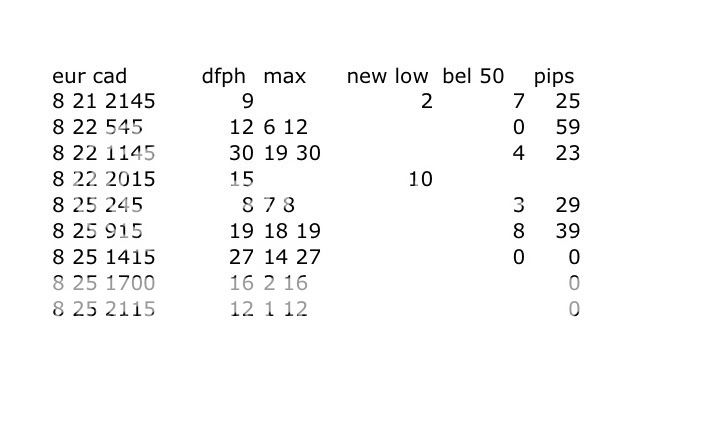K
kylefoley76
i may be on the cusp of discovering a highly profitable strategy but i haven't as yet discovered exactly how to replicate it by defining the precise conditions under which the strategy works. right now this uses the 15 minute time frame. the following is a chart of the euro/cad in august of 2008. what happens is that by just using the stochastic as one's indicator one can make a successful trade five times out of nine, 3 trades breaking even and only losing once. i of course want to do more research on this to find what exactly is happening here that these positive profits are possible. if i can identify this trend in other currencies so that i can replicate these profits that of course will be a significant discovery but at the moment i don't know exactly why it is that armed with only the stochastic one is able to choose tops with such positive regularity and also able to draw a rather tight stop loss. although i haven't yet done an elaborate study if things continue as they are it looks as though we can average about 75% success with risk-reward ratios of about 2 to 1 or 3 to 1 with an occasional 5 to 1 here and there. this translate to about two dollars earned for every one dollar risked.
here's the chart:

just by looking at it right off the bat one can see that the currency pair stays in a very narrow range which could be the key to its success. i put the bollinger band width at the bottom which might be a valuable tool in being able to recognize this pattern in other currency pairs, as you can see it is very low. it is trending downwards at a rate of about 100% per year.
here's how the strategy works. you enter after the stochastic rises above 75 then retraces for one bar. (out of these 9 trades the 75 threshold worked just as well as a threshold of 80, 85 or 90, though in other conditions i have seen that a stochastic reading of 90 works better than 80, also we are only using the fast stochastic, the slow stochastic is ignored). also we are only going short since the instrument is trending down, ignore the stochastic if it reads oversold. so in the following chart:

the august 22nd 22:00 candle is the first candle that signals a reversal. we then measure the difference between the last high and the price that the first candle closes at. the price will usually revisit this former high, sometimes even making a new high. we then wait three bars for the price to reach 50% of the way from the close of the candle to the previous high, this is where we enter. we then draw our stop loss about 9 or 10 pips above. i have not yet done an elaborate study but in the future i would like to find a more statistically significant way to draw the stop loss, because let's face it before the financial crisis when volatility was down a 9 or 10 pip stop loss was possible but now it's not. sometimes the price never retraces 50% of the former high and the close of the candle so we won't enter. in these nine trades, according to my strategy we only enter into 7 of them. after more data is collected it may show that entering at a 66% level or a 75% level is better. remember you don't lose by money by refusing to enter a trade.
as far as exiting is concerned i haven't yet done a lot of research on exit strategies so i don't have any formula but i did come up with some rough possible rewards for each of the following entries just so as to get a vague idea as to what kinds of profits we're looking at. in any case in looking over the 9 trades the average reward seems to be about 22 pips, though higher rewards are certainly not out of the question. so if you're risking 9 or 10 pips you're looking at some good profits.
let me also state here that i haven't as yet placed a forex trade in my life. i'm still researching. it turns out that i find the research of price movements so fascinating that the temptation to get in there and get my sleeves ruffled is just not there. i have done about 30 trades in the stock market and lost a 100 dollars but that's it.
here's how to interpret the following table:
the first column represents the time of the entry, day, month, minute.
dfph - distance from previous high, that is the distance from the first signal candle from the last high.
max - this is the amount that the price retraced towards the previous high over the next 3 bars after the signal triggered. the second number is the same as the distance from the previous high, the first number is the actual distance. so if the dfph was 19 and over the next 3 bars the price eventually retraced 8 pips then that would read 8 19, i wanted it to be like a fraction.
new low - if the price eventually goes higher than the previous high then i wrote down how many pips it superceeded the previous high. technically that column should read new high instead of new low.
bel 50 - stands for below the 50% mark, which means we enter if the price eventually retraces towards the previous high by 50%. so if the former high was 20 pips away then we enter if the price should retrace by 10 pips. the number then is how many pips the price went beyond that 50% mark. this number is very important for drawing the stop loss. as you can see this number ranges from 0 to 8. there is one whipsaw which eventually went to 10 or 17 since we would have entered when the price retraced to within 7 of the previous high. we would have lost money on that trade.
pips - this is a rough amount of how much reward we might have gotten if we employed an effective exit strategy. the 3 zeroes are due to the fact that i exit trades if the price rises but doesn't reach a satisfying amount and begins to turn south. if it does turn south i get out at the break even point though i haven't yet researched whether or not this is a profitable strategy.

here are charts of the other entries:



here's the chart:

just by looking at it right off the bat one can see that the currency pair stays in a very narrow range which could be the key to its success. i put the bollinger band width at the bottom which might be a valuable tool in being able to recognize this pattern in other currency pairs, as you can see it is very low. it is trending downwards at a rate of about 100% per year.
here's how the strategy works. you enter after the stochastic rises above 75 then retraces for one bar. (out of these 9 trades the 75 threshold worked just as well as a threshold of 80, 85 or 90, though in other conditions i have seen that a stochastic reading of 90 works better than 80, also we are only using the fast stochastic, the slow stochastic is ignored). also we are only going short since the instrument is trending down, ignore the stochastic if it reads oversold. so in the following chart:

the august 22nd 22:00 candle is the first candle that signals a reversal. we then measure the difference between the last high and the price that the first candle closes at. the price will usually revisit this former high, sometimes even making a new high. we then wait three bars for the price to reach 50% of the way from the close of the candle to the previous high, this is where we enter. we then draw our stop loss about 9 or 10 pips above. i have not yet done an elaborate study but in the future i would like to find a more statistically significant way to draw the stop loss, because let's face it before the financial crisis when volatility was down a 9 or 10 pip stop loss was possible but now it's not. sometimes the price never retraces 50% of the former high and the close of the candle so we won't enter. in these nine trades, according to my strategy we only enter into 7 of them. after more data is collected it may show that entering at a 66% level or a 75% level is better. remember you don't lose by money by refusing to enter a trade.
as far as exiting is concerned i haven't yet done a lot of research on exit strategies so i don't have any formula but i did come up with some rough possible rewards for each of the following entries just so as to get a vague idea as to what kinds of profits we're looking at. in any case in looking over the 9 trades the average reward seems to be about 22 pips, though higher rewards are certainly not out of the question. so if you're risking 9 or 10 pips you're looking at some good profits.
let me also state here that i haven't as yet placed a forex trade in my life. i'm still researching. it turns out that i find the research of price movements so fascinating that the temptation to get in there and get my sleeves ruffled is just not there. i have done about 30 trades in the stock market and lost a 100 dollars but that's it.
here's how to interpret the following table:
the first column represents the time of the entry, day, month, minute.
dfph - distance from previous high, that is the distance from the first signal candle from the last high.
max - this is the amount that the price retraced towards the previous high over the next 3 bars after the signal triggered. the second number is the same as the distance from the previous high, the first number is the actual distance. so if the dfph was 19 and over the next 3 bars the price eventually retraced 8 pips then that would read 8 19, i wanted it to be like a fraction.
new low - if the price eventually goes higher than the previous high then i wrote down how many pips it superceeded the previous high. technically that column should read new high instead of new low.
bel 50 - stands for below the 50% mark, which means we enter if the price eventually retraces towards the previous high by 50%. so if the former high was 20 pips away then we enter if the price should retrace by 10 pips. the number then is how many pips the price went beyond that 50% mark. this number is very important for drawing the stop loss. as you can see this number ranges from 0 to 8. there is one whipsaw which eventually went to 10 or 17 since we would have entered when the price retraced to within 7 of the previous high. we would have lost money on that trade.
pips - this is a rough amount of how much reward we might have gotten if we employed an effective exit strategy. the 3 zeroes are due to the fact that i exit trades if the price rises but doesn't reach a satisfying amount and begins to turn south. if it does turn south i get out at the break even point though i haven't yet researched whether or not this is a profitable strategy.

here are charts of the other entries:



